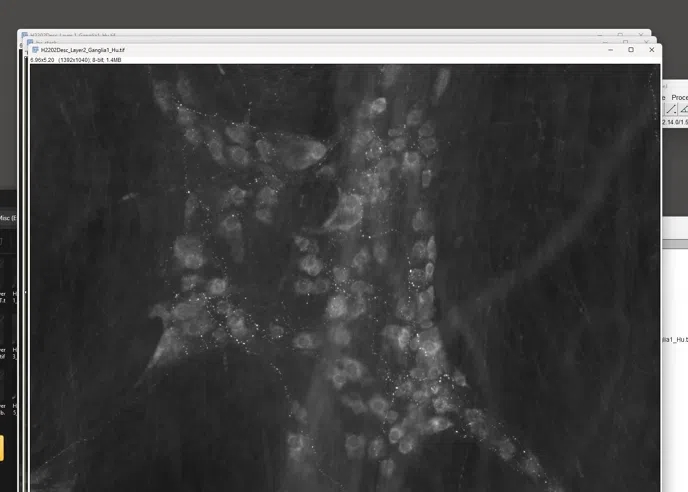Multiplex image alignment
Register images from multiplexed imaging round
Data Organization
The images from each round are expected to be in 2D and as an image sequence. All the images need to be in the same folder and they have to follow a naming convention:
XXXX_layer1_markername.tif
The XXXX can be anything you want. markername should be name of the marker or label you use for that image.
For example, if a multiplexing round is called "Layer" and each round has a number, then images from first round should have Layer 1 or layer1. So, if sample id is sample1, its the first round and marker is Hu, then image name should me `sample1_layer1_Hu.tif`. The names can have a mix of upper and lowercase.
For example, we're using data from Chen et al. 2023, specifically myenteric wholemount from the descending colon. Multiple ganglia were imaged, so the naming convention we've used is:
H2202Desc_Layernumber_Ganglia1_marker.tif
The layer number and marker change with each file.
For this dataset, we have:
14 different markers
6 different rounds of staining
Every round has pan-neuronal marker Hu as a reference marker.
So, if the images were in E:/Multiplex, then the images will be organized like this:
├──E:/Multiplex
│ ├── H2202Desc_Layer 1_Ganglia1_Hu.tif
│ ├── H2202Desc_Layer1_Ganglia1_5HT.tif
│ ├── H2202Desc_Layer1_Ganglia1_ChAT.tif
│ ├── H2202Desc_Layer1_Ganglia1_NOS.tif
│ ├── H2202Desc_Layer2_Ganglia1_CGRP.tif
│ ├── H2202Desc_Layer2_Ganglia1_Enk.tif
│ ├── H2202Desc_Layer2_Ganglia1_Hu.tif
│ ├── H2202Desc_Layer2_Ganglia1_SP.tif
│ ├── H2202Desc_Layer3_Ganglia1_Hu.tif
│ ├── H2202Desc_Layer3_Ganglia1_Somat.tif
│ ├── H2202Desc_Layer3_Ganglia1_VAChT.tif
│ ├── H2202Desc_Layer4_Ganglia1_Hu.tif
│ ├── H2202Desc_Layer4_Ganglia1_NPY.tif
│ ├── H2202Desc_Layer5_Ganglia1_Calb.tif
│ ├── H2202Desc_Layer5_Ganglia1_Calret.tif
│ ├── H2202Desc_Layer5_Ganglia1_Hu.tif
│ ├── H2202Desc_Layer5_Ganglia1_NF.tif
│ ├── H2202Desc_Layer6_Ganglia1_Hu.tif
│ ├── H2202Desc_Layer6_Ganglia1_VIP.tifPleas note that we've only tested this on images of size 1500 x 1500 pixels in size. If you're having trouble running this on other image sizes, do get in touch.
Now we'll go through the analysis pipeline. The data for this tutorial can be downloaded from Zenodo.
Note:
While the example provided uses Hu as the reference image for alignment purposes, you may select any marker that effectively labels the majority of structures of interest within your samples. For instance, DAPI is commonly used as a reference marker in many fluorescent imaging protocols, due to its strong and consistent labelling of all cell nuclei.
Successful alignment depends heavily on the the quality of the reference marker labeling
Analysis Steps
1. The images from various rounds are stored with the specified naming convention

2. Go to GAT->Multiplex->Multiplex Registration

3. Select the directory. Enter the name of the reference marker present across all rounds, in this case "Hu". Enter the number of rounds of multiplexing. Also enter the name that distinguishes each round of multiplexing. In this case, we've entered "Layer".
You can also choose a different folder to save your data or finetune your alignment parameters by ticking the boxes below.
Click Ok when you're done.

4. Once you click Ok, the images from each round will open up and the alignment process begins. Information will be printed out to the Log window. An ROI Manager file will also appear which contains the landmarks for alignment.

5. Once you're done, you'll be left with your aligned image!

6. The Results will be saved in the save_directory selected before.

7. The Results folder will contain the aligned image stack. It will also contain a stack of reference channels from each round, in this case Hu with a corresponding ROI manager file. This ROI Manager file contains landmarks used to align Hu channel from each round to the reference image, which is the image from the first round/layer of multiplexing

References
Lowe, D. G. (2004). Distinctive Image Features from Scale-Invariant Keypoints. International Journal of Computer Vision, 60(2), 91–110. doi:10.1023/b:visi.0000029664.99615.94
Brown, M., Szeliski, R., & Winder, S. (n.d.). Multi-Image Matching Using Multi-Scale Oriented Patches. In 2005 IEEE Computer Society Conference on Computer Vision and Pattern Recognition (CVPR’05). IEEE. doi:10.1109/cvpr.2005.235
Fischler, M. A., & Bolles, R. C. (1981). Random sample consensus. Communications of the ACM, 24(6), 381–395. doi:10.1145/358669.358692
Last updated
Was this helpful?

